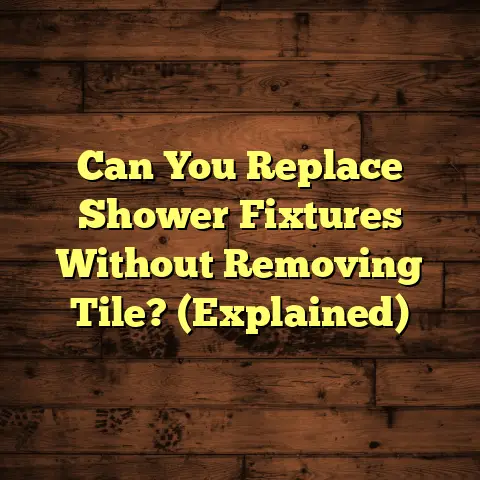Fix Lifting Fake Wood Floor Now! (1-Day Repair Trick!)
Have you ever stepped onto your beautiful fake wood floor only to feel it lifting beneath your feet, leaving you frustrated and unsure of how to fix it?
I know that feeling.
It’s like a little betrayal by your own home!
But don’t worry, you’re not alone, and it’s definitely fixable.
Let’s dive into how you can tackle this problem quickly and effectively.
Understanding Fake Wood Flooring
So, what exactly is “fake wood flooring”?
Basically, it’s any flooring that looks like wood but isn’t actually solid hardwood.
We’re talking about things like:
- Laminate: Made of pressed wood with a photographic layer and a protective top coat.
- Vinyl: Available in planks or tiles, often waterproof, and mimics wood grain patterns.
- Engineered Wood: A thin layer of real wood veneer over a plywood or fiberboard core.
Why do people choose these options? Well, there are tons of reasons:
- Aesthetics: You get the look of hardwood without the hardwood price tag.
- Cost-Effectiveness: Fake wood is generally much more budget-friendly than real wood.
- Ease of Installation: Many types are designed for DIY installation, saving you money on labor.
But here’s the thing: even though these floors are durable, they’re not immune to problems.
One of the most common issues? Lifting.
This can be caused by environmental factors like humidity, temperature changes, poor installation, or just wear and tear over time.
Identifying the Problem
Okay, so how do you know if your fake wood floor
is actually lifting?
Look out for these telltale signs:
- Gaps: Notice spaces between the planks or tiles where they used to fit snugly?
- Bubbles: Are there raised areas or “bubbles” underneath the flooring?
- Separation at the Seams: Are the edges of the planks or tiles pulling away from each other?
What causes this lifting, anyway? Here are a few culprits:
- Moisture Damage: This is a big one.
Water can seep underneath the flooring and cause it to swell and lift. Improper Acclimation: Fake wood flooring needs to adjust to the humidity and temperature of your home before installation.
If you skip this step, you’re asking for trouble.According to the North American Laminate Flooring Association (NALFA), laminate flooring should be acclimated for at least 48 hours in the room where it will be installed to ensure stability and minimize the risk of lifting or buckling.
-
Subfloor Issues: If the subfloor (the layer underneath your flooring) isn’t level or is damaged, it can cause the flooring above to lift.
I remember one client who had installed beautiful laminate flooring in their basement.
Within a few months, they started noticing significant lifting, especially near the walls.
Turns out, they hadn’t properly waterproofed the basement,
and moisture was creeping up through the concrete slab.
The fix was a lot more involved than just re-gluing the planks!
The Importance of Timely Repairs
Why is it so important to fix lifting floors ASAP?
Well, for starters, it can lead to:
- Further Damage: The longer you ignore the problem,
the worse it will get.
Moisture can continue to seep in, and the lifting can spread. - Increased Repair Costs: A small repair now can prevent a major (and expensive) replacement later.
- Safety Hazards: Lifting floors can create tripping hazards, especially for kids and older adults.
Beyond the practical stuff, there’s also the psychological impact.
Let’s be honest: a damaged floor just looks bad.
It can make your whole house feel less appealing,
and it can even affect your home’s value.
Nobody wants to show off a house with bubbling floors!
The 1-Day Repair Trick
Alright, let’s get to the good stuff: the “1-Day Repair Trick.”
This is a quick and effective way to tackle lifting fake wood floors, assuming the damage isn’t too extensive.
Step 1: Gather Necessary Tools and Materials
You’ll need:
- Utility knife
- Appropriate adhesive for your flooring type (check the manufacturer’s recommendations)
- Caulk gun (if your adhesive comes in a tube)
- Clean cloths or paper towels
- Weights (books, bricks, or anything heavy and flat)
- Painter’s tape
- Safety Glasses
- Gloves
Step 2: Assess the Lifted Area
Take a good look at the damage.
How big is the lifted area? What seems to be causing it?
Is it just a small section, or is it widespread?
This will help you determine the best approach.
Step 3: Prepare the Floor
This is crucial. You need to clean the area thoroughly.
Use a vacuum to remove any debris, dust, or dirt.
Then, wipe the area with a damp cloth (make sure it’s not soaking wet!) to remove any remaining residue.
Let it dry completely before moving on.
Step 4: Apply Adhesive or Repair Solution
Now, for the magic!
Choose the adhesive that’s specifically designed for your type of flooring.
Follow the manufacturer’s instructions carefully.
Generally, you’ll want to apply a thin, even layer of adhesive to both the underside of the lifted flooring and the subfloor.
If you’re using a caulk gun, apply a bead of adhesive around the perimeter of the lifted area.
Step 5: Flatten and Secure
Carefully press the lifted flooring back into place.
Make sure it’s aligned properly with the surrounding planks or tiles.
Now, grab those weights you gathered earlier.
Place them directly on top of the repaired area to hold it down firmly.
You can also use painter’s tape to secure the edges.
Step 6: Allow to Cure
This is the hardest part: waiting!
The adhesive needs time to set properly.
Check the manufacturer’s instructions for the recommended curing time.
It’s usually at least 24 hours, but it could be longer.
Avoid walking on the repaired area during this time.
For instance, Loctite PL Premium Construction Adhesive, a popular choice for flooring repairs, typically requires 24 hours to cure fully under normal conditions, but may take longer in high humidity or low temperatures.
Tips for Successful Repair
Want to make sure your repair is a success?
Here are a few insider tips:
- Read the Instructions: I know it sounds obvious, but
really, read the instructions for both the flooring and the adhesive.
Manufacturers know their products best. - Don’t Overdo the Adhesive: Too much adhesive can create
a mess and prevent the flooring from sitting flush.
A thin, even layer is all you need. - Use the Right Tools: A utility knife with a sharp blade
is essential for making clean cuts.
A caulk gun will make applying adhesive much easier. - Be Patient: Don’t rush the process.
Take your time and make sure everything is aligned properly before applying the weights.
One common mistake I see people make is using the wrong type of adhesive.
Using a general-purpose adhesive instead of one specifically designed for flooring can lead to a weak bond and a failed repair.
Another mistake is not cleaning the area thoroughly enough.
Dirt and debris can prevent the adhesive from bonding properly.
Preventing Future Lifting
Okay, you’ve fixed the problem. Now, how do you prevent it from happening again?
- Proper Installation: This is key.
Make sure your flooring is installed correctly from the start.
Follow the manufacturer’s instructions and hire a professional if you’re not comfortable doing it yourself. Maintain Optimal Humidity Levels: Excessive humidity can cause fake wood flooring to swell and lift.
Use a dehumidifier in damp areas like basements.The ideal humidity level for most homes is between 30% and 50%.
Investing in a hygrometer, a device that measures humidity, can help you monitor and maintain the right conditions to prevent flooring issues.Regular Inspections: Keep an eye on your floors.
Look for any signs of lifting, gaps, or bubbles.
The sooner you catch a problem, the easier it will be to fix.- Use a Good Underlayment: Underlayment is a layer of material
that goes between the subfloor and the flooring.
It can help to cushion the flooring, reduce noise, and prevent moisture-related issues.
When to Call a Professional
Sometimes, a DIY repair just isn’t enough.
Here are some scenarios where you should call a professional:
- Extensive Damage: If the lifting is widespread or severe, it’s probably beyond the scope of a DIY repair.
- Underlying Subfloor Issues: If you suspect there’s a problem with the subfloor (e.g., it’s uneven, damaged, or rotting), you’ll need a professional to assess and fix it.
- Moisture Problems: If you have a persistent moisture problem (e.g., a leaky pipe or a damp basement), you’ll need to address the source of the moisture before you can repair the flooring.
- You’re Not Comfortable: If you’re not confident in your
ability to do the repair correctly, it’s always best to call a professional.
It’s better to spend a little money now than to make the problem worse.
Signs that indicate a more serious underlying issue include:
- Visible Mold or Mildew: This is a sign of significant moisture damage.
- Soft or Springy Spots in the Subfloor: This indicates rot or decay.
- Persistent Odors: A musty or moldy smell can indicate hidden moisture problems.
Conclusion
So, there you have it: the 1-Day Repair Trick for fixing lifting fake wood floors.
Remember, addressing these issues promptly and effectively is key to maintaining the beauty and functionality of your home.
Don’t let a little lifting ruin your day (or your floor!).
Take action, restore your flooring, and enjoy the comfort and beauty of your home.
Call to Action
Now, I want to hear from you!
Have you ever dealt with lifting fake wood floors?
What tips or tricks have you discovered along the way?
Share your experiences in the comments below!
Let’s learn from each other and make sure everyone has beautiful, stable floors to walk on.





